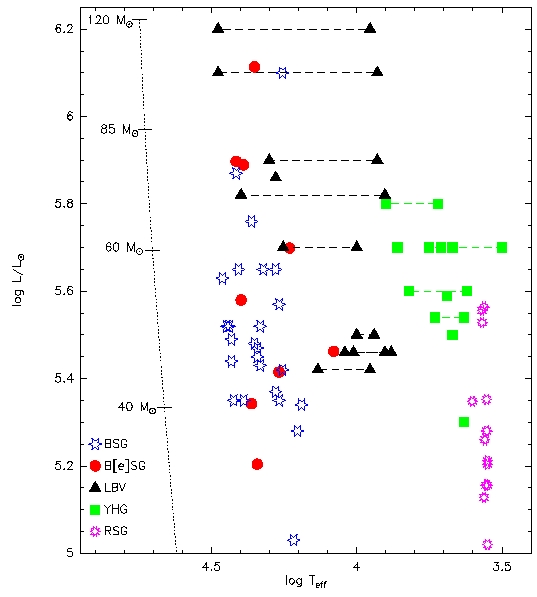The post-main sequence evolutionary path of massive stars hosts several interesting phases. These are the red supergiant and yellow hypergiant phases (RSG and YHG, respectively), the luminous blue variable phase (LBV), the Wolf-Rayet phase (WR), and the hardly understood B[e] supergiant (B[e]SG) phase. Stars belonging to these phases are known to undergo strong mass loss by stellar winds and/or strong shell ejections. However, the physical causes of the mass loss in these phases is still not understood which makes it difficult to properly implement the mass-loss over the course of stellar evolution into the theoretical model computations.

In the above figure we plotted the upper part of the Hertzsprung-Russell diagram (HRD) which hosts the most massive stars, i.e., stars that were born with more that 30 solar masses. The dotted line to the left marks the zero-age main sequence; some individual initial masses of stars are indicated. The right part of the HRD is filled with stars in different phases of the post-main sequence evolution as indicated by the different symbols. We did not include here WR stars, but instead some classical B-type supergiants (BSG), which are stars that have just left the main-sequence, hence cooling and expanding in size. From this plot it is obvious that some phases extend over large luminosity and temperature ranges; especially LBVs and YHGs show a variety of temperatures when observed at different dates. The range between minimum and maximum temperature values as recorded for these stars, is indicated by the dashed lines. The spread of the different phases over large regions in the HRD consequently results in an overlap. The coexistence at the same location in the HRD of , e.g., the B[e]SG and the LBVs makes it difficult to link these specific phases evolutionary. This means that we cannot tell so far whether the B[e]SG are the progenitors or the decendants of LBVs, or whether stars with specific initial conditions evolve independently and become either an LBV or a B[e]SG. Even worse, even modern stellar evolution theories cannot predict the B[e]SG phase at all.
To improve our knowledge on especially the evolutionary connections between these individual phases of massive post-main sequence evolution, we study some of them in more detail. So far, we were concentrating on the group of B[e] stars (mainly focusing on the B[e]SG), but we also started to investigate classical B-type supergiants and some members of the fascinating group of Yellow Hypergiants which are, like the B[e]SG, not predicted by current stellar evolution theories.